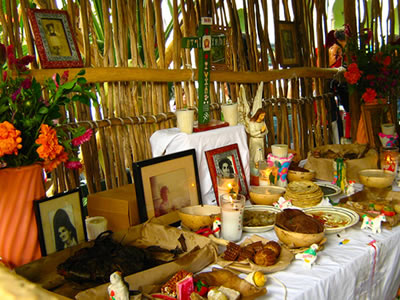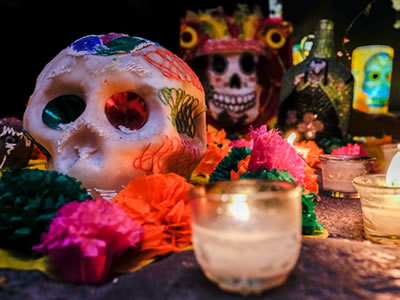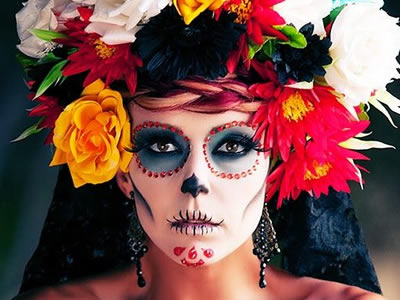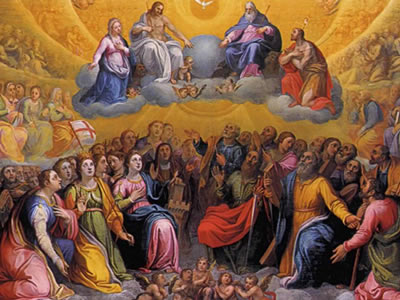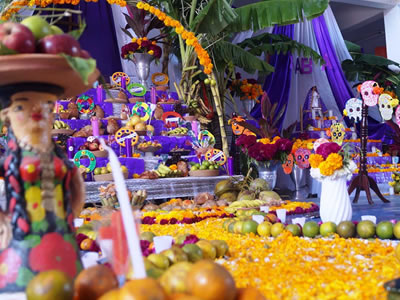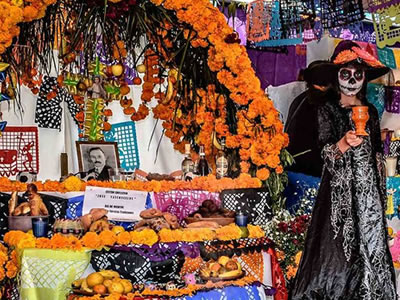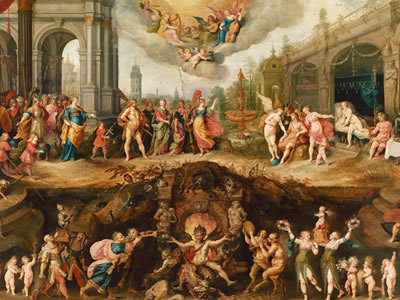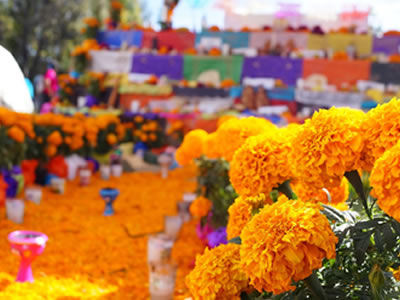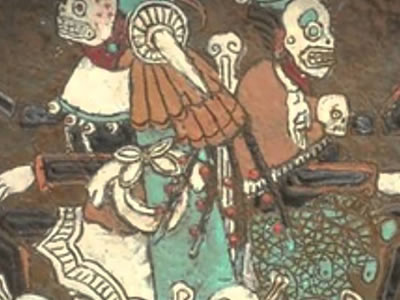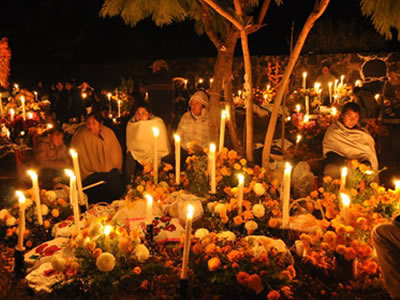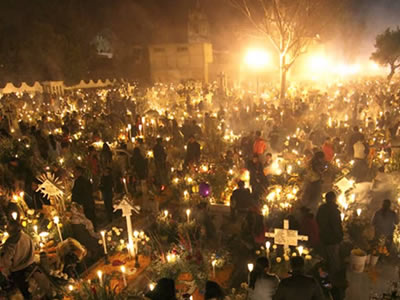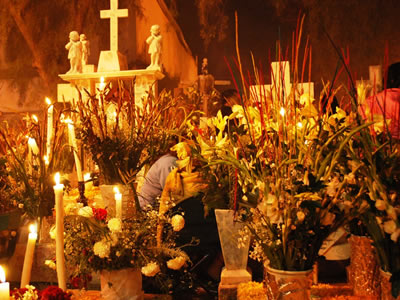
The Day of the Dead - Listed by the UNESCO as an Intangible Cultural Heritage of Humanity.
The Day of the Dead is a Mexican holiday that has spread in popularity into parts of the United States and across Latin America. It is celebrated from October 31 through November 2, to coincide with both the American tradition and the Catholic holy days. Those three days are dedicated to all of the dead.
All Saints' Day is a solemn holy day of the Catholic Church celebrated annually on November 1. The day is dedicated to the saints of the Church, that is, all those who have attained heaven. It should not be confused with All Souls' Day, which is observed on November 2, and is dedicated to those who have died and not yet reached heaven.
"The Day of the Dead" practiced by the Aztecs and other indigenous groups in Mexico and throughout Mesoamerica existed many years prior to the arrival of the Spaniards and even before the birth of Jesus Christ. It is a clear example of the syncretism between the Mesoamerican Cultures and the Catholic Religion. To exemplify this, we will refer to the Aztec Culture.
The Aztecs celebrate their deceased (children and adults) in the months of July and August respectively. Well, as part of the conquest, in this theological case and with the purpose of converting the Indians to Catholicism, the Catholic Religion accommodated these celebrations to its calendar and because of this reason, the celebration of "Day of the Dead" is carried out from October 31 to November 2.
Images
All Saints Day (November 1st)
The Aztecs used to remember their deceased Children with great Nostalgia, Pain and at the same time with Hope; they believed in reincarnation and in the immortality of the Soul; therefore, they were convinced that very soon the Souls of their Children would be returned to life in another newborn child. For this reason, unborn children used to be buried inside earthen vessels that symbolized the womb of the Mother.
Now, if we ask ourselves the following question: What kind of sin could a child have committed who died at a very early age?
The answer is correct: None; then, if they have never committed a sin and are already dead, then all the children in these conditions are Saints; so we can say that Children are “All Saints”.
For this reason, the Catholic Religion moved the celebration that the Aztecs held to remember their "Deceased Children” to November 1st, when they celebrate the "Day of All Saints".
Images
All Souls’ Day (November 2nd)
The Catholic Religion remembers the deceased people and prays for them, especially for the souls who are in purgatory because in life they were not good enough to go to heaven or they were not so bad as to go directly to hell.
In contrast, for the Aztecs what determines the place to which souls would go after death depends on how people died.
Omeyocan: The following dead were sent to this site, the Warriors that died in battle, the Pochtecas (merchants) who died defending themselves when they were assaulted and also the Women who died during childbirth, since they died fighting a battle against death to give life. It was considered an honor to die in battle.
Tlalocan: The place where Tlaloc, the God of Water, resides. Those who were sent there died for causes related to water, such as drowning, accumulation of liquids or those struck by lightning during a storm, etc.
Chichihuacuauhco: The place where children and stillborn were sent, to be feed with milk from the Nodriza (wet nurse) trees that emanated milk from its tits instead of flowers or fruits, until it was time to return to Earth.
Mictlan: In contrast, the people who died by natural causes went to the "Mictlan", the Underworld of the Aztecs where the lord and lady of death Mictlantecuhtli and Mictecacíhuat lived. They are waiting for the deceased who had surpassed the nine levels of the underworld in a period of four years, during which, they could stop and return home to be feed and regain their strength; it is believed that this is one of the possible origins of altar offerings of the Day of the Dead.
At the end of their journey, the dead arrive at a place where there is a thick fog that prevents them from seeing; but instead, it incites the travelers to reflect on their actions during their lives. Reflecting on everything that happened to them throughout their lifetime up until their moment of their death, ceasing to suffer and becoming one with death when they entered the yearned Mictlan the place of the dead, so they could fulfill their earthly dream of eternal peace.
Due to the above, specifically because of the similarity between Purgatory and Mictlan, the Catholic Religion arranged the celebration of the Aztecs to their "Deceased Adults" for November 2, when they celebrate the "Faithful Dead."
Images
The Day of the Dead in San Andrés Mixquic
In San Andrés Mixquic the Day of the Dead is not only a reason to spend time together with the family remembering that loved ones who has passed away; It is also a great opportunity to spend a very nice and special time with the Spirits of the dead love ones that returns to earth for this special celebration.
According to the tradition, on October 31st at 12:00 hr (midday), the Spirits of the Children arrives and they are welcome making the bells of the church sound and with firework. The day after at the same time, they leave and the Spirits of the adults arrives and they are welcome in the same way. Then, on November 2nd the adults leaves at noon but this special celebration continuous at home eating the food they put at the altar.
People create Altars in honor of the dearly departed decorated with fresh flowers of cempasúchil (marigolds) and with their petals people makes a pathway from the main entrance of the house to the place the Altar is, with the purpose of make easier the entrance of the Spirits.
The Altar also has pictures of the love ones passed away, candles, some religious images, fruit, plates of turkey mole, pan de muerto (bread of the dead), tamales, bottles of soda, coffee, beer, tequila and mezcal, even cigarettes, toys and candies for the angelitos (children), sugar Calaveras and any other type of food or drink that the dead people loved in life.
For the Aztecs the Calaveras or skulls represent the life cycle, and are still part of the celebration, from candied skulls, decorated with brightly colored sugar crystals to vibrant ceramic skulls lined up in rows at the local market.
In San Andres Mixquic during the day, mourners make their respectful procession to the cemetery surrounding the San Andres Apostol, a former Convent, where their family-owned plots are loaded with relatives spanning generations. People come in to the cemetery to remove the dust from the Tombs and decorated them in the same way as the altars, scattered with cempasúchil, ofrendas and candies sweets.
After nightfall, families gather graveside and pay tribute to the spirits of the deceased with an all-night vigil. Shadows dance on the granite crosses cast by twinkling candlelight. Incense burns a thick dense fog. Cleansing rituals to remove spiritual impurities are performed. Patriarchs read a slow, morose roll call of the departed from the head of the grave. Glass-eyed mortals lost in a reverie of remembrance pray silently. It is incredibly moving to glimpse this collective grief.
In addition, in some places it is common to see the famous Catrinas, one of the most iconic images of the "Day of the Dead", a woman dressed elegantly but with a cadaverous face and was a form of mockery by the People towards the Women of the High Society but at the same time, it is a clear message for rich and poor: "All of Us are Equal when We Face Death".
The Day of the Dead is a celebration full of contrasts; there is Joy and at the same time there is Sorrow. The Altars and the Tombs are full of color and at the same time they are stained black, the Living Celebrate the Dead, all at the same time, just as Life is.
In Mexico, Death is understood as a natural condition of Life and adults face it with great respect and aplomb; and children, begin to realize that Life, not You or Us, Life, is forever.
We are sure you will love this tour.
Images
GENERAL INFORMATION
Places to visit
- San Andrés Mixquic
Travel Information
- Duration:
- Start Time:
- Languages:
- Travel:
- It includes:
- Tourist guide accredited by SECTUR
- Bottled water and wet towels
- Does not Include:
- Alcoholic drinks
- Gratifications
Recommendations
- Dress and fit comfortably preparándose para clima frío
- Bring valid identification
What vehicle to request?
The vehicle in which the service will be performed is based on the number of people who make the journey; namely:
1 - 2
people
SEDAN
3 - 6
people
SUBURBAN
7 - 10
people
EXPRESS VAN
11 - 18
people
SPRINTER
19 - 50
people
BUS
Are you interested in this tour?
At Golden Crown we are ready to assist you, help and advise you if necessary.
If you need additional information or a quote, do not hesitate to send us an email.
You will receive an answer shortly.
WHY HIRE OUR SERVICES?
In Golden Crown™ we are kind, attentive, helpful, respectful and honest. We have the experience that the years of service have left us; however, we know that experience is not a finished product and that is why we are always willing to learn something new and to share it with our colleagues. In this way, we can provide a better service to our customers; and at the same time, we can be better human beings, useful to ourselves, to our families, to our Society and to our Country and in a general way, useful to Humanity.
Our Experience: We have more than 10 years of experience as Golden Crown™; therefore, you can be sure that our work team has the necessary knowledge to provide a safe, highly efficient and personalized service.
The Quality of our Vehicle Fleet: The maintenance we give our vehicles guarantees to reach their destination safely and without any setbacks.
The Service to our Clients: We are proud of the service we provide our clients and we make sure to continue doing it every day with the best attitude.
